Notre Dame couldn’t establish an efficiency advantage for the first time since Ian Book took over the offense, but countered with a Dexter Williams-led win in explosiveness. The Irish also continued their excellence limiting scoring opportunities to create a big advantage in points per scoring chance, with some thanks due to Justin Fuente and his affinity for field goal attempts.
Basics

The high-level box score was almost dead-even, although it took the Hokies nearly 20 more plays to approach Notre Dame’s total yardage. Despite allowing more scoring opportunities to Virginia Tech, Justin Fuente settled for five field goal attempts and a defensive touchdown was a game-changing play. Technically this game went in and out of garbage time (up 21+ in the 4th quarter) late, but for our purposes it began with Julian Love’s late interception. As a result only 4.7% of plays were thrown out – hardly changing much, but let’s take a second to appreciate the absurdity of garbage time at VT and versus Stanford while not having any against Vanderbilt and Ball State.
Efficiency
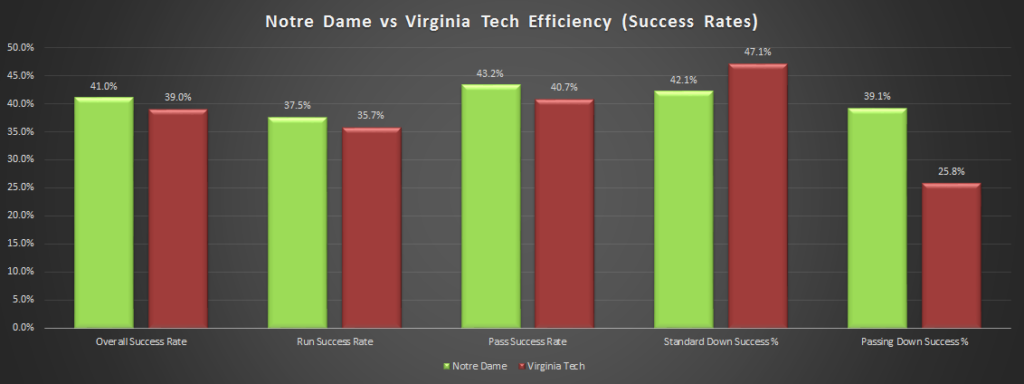
At halftime, I found myself just hoping for an escape from Lane Stadium. It had initially appeared Notre Dame had advantages on both sides of the football – going up to a quick 10-0 lead on a suspect pass defense, and with the top-5 defense ready to quiet the crowd. Then, suddenly, a semi-disastrous series of events took place that seemed to set things up put a stroke-inducing second half.
My biggest fears for the game involved turnovers, special teams, penalties, and the offense bogging down facing a stout run defense and with Ian Book due for some regression. Then in the second quarter, all of those boxes were checked with 15 minutes:
- A botched snap to Tyler Newsome resulted in a loss of yards on 4th down (essentially a turnover)
- Book’s accuracy (particularly attempting some deep balls) led to inefficiency (a 21% pass play success rate in the 2nd quarter)
- A bad read on an RPO led to Book throwing a gift interception directly to Virginia Tech’s Reggie Floyd
- With just 1:08 remaining, the defense let up a 75-yard touchdown drive in under a minute to the Hokies, including Julian Okwara ejected for targeting
Yes, it was Murphy’s Law bingo, and the halftime lead felt a little tenuous. Then the Irish averaged 10 yards per play before garbage time in the second half to the Hokie’s 5.6. It was a strong display of mental toughness, execution, and coaching adjustments (for a second consecutive week, dominating a quality opponent after halftime).
While the Notre Dame offense didn’t put up another insanely efficient performance, it was again a balanced effort against a disruptive Bud Foster defense. Both the running and passing games ran hot and cold at times, but ended the day averaging over 7 yards per pass (7.03, including sacks) and per rush (7.79). The Irish offense was terrific on 3rd down, including converting on 6 of 11 3rd down passing downs (3rd and 5+).

The defensive effort (5.27 YPP) was the second worst by yards per play so far in this young season (Vanderbilt tallied 5.91 YPP), but continued its excellence in the critical areas of the field. That “down” effort of 5.27 YPP is also better than the defensive average of every team left on the schedule with the exception of FSU (4.91), for context of the extremely high bar this group has set for itself. The defense bent a decent amount on standard downs, including giving up a 53% success rate against VT runs in the first half, bu capitalized on passing downs when the Hokies were behind schedule.
Explosiveness
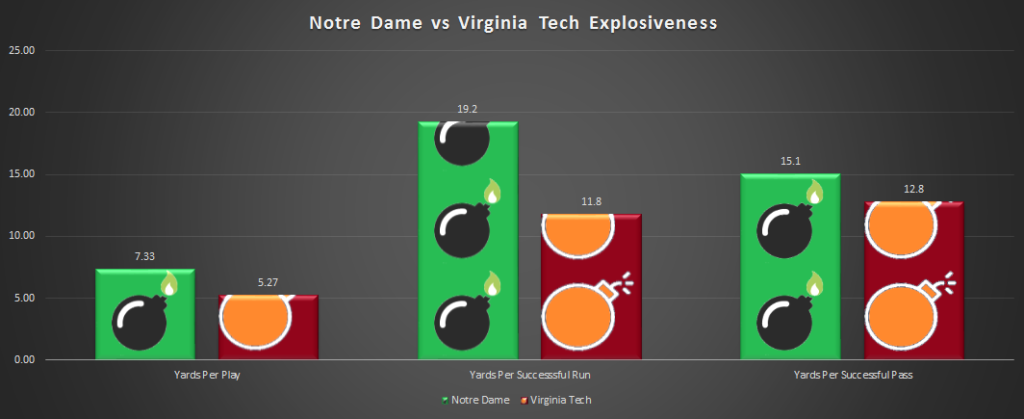
Before garbage time the Irish outgained Virginia Tech on the road by +2.06 yards, making up for an almost dead heat in efficiency with added explosiveness. The Dexter Williams 97 yarder was the easy highlight, but the first Boykin touchdown off Ian Book’s scramble was a sneaky-long 40 yarder to add to the early 56 yard Finke grab.
We’ve now seen the new edition of the Book-led offense succeed utilizing two different styles, which is pretty encouraging. The Wake Forest and Stanford games were hyper-efficient offensively, with some solid chunk plays sprinkled in. This performance was fairly averaged from a success rate standpoint, but with devastating explosiveness in a few key plays that changed the game.
I’m excited by the complementary nature of the Dexter-Book combination. Book in Chip Long’s offense is going to be more of a high-efficiency QB, and thus far has brought plus-plus accuracy to the table on short and intermediate throws. That’s a strong foundation, as enough successful plays and eventually a blown coverage or busted tackle leads to big gains where maybe they weren’t anticipated. Add Williams to the rushing attack and now you have a high-explosiveness option with the threat of a long TD or two a game.
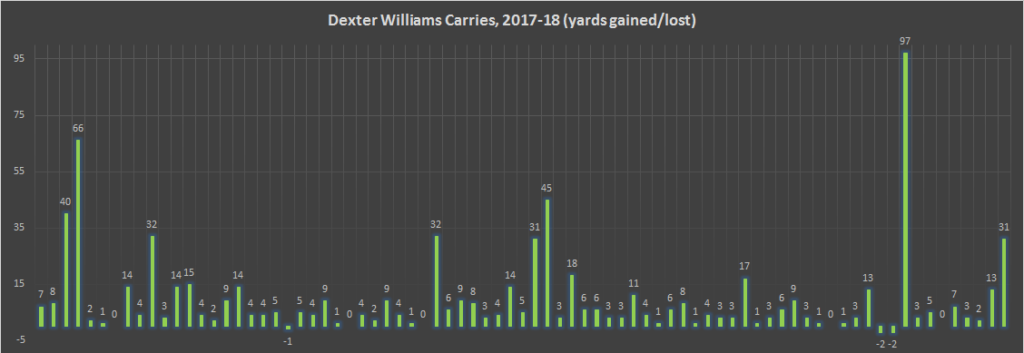
It’s a small sample size over the past two seasons, but basically one of every ten Williams carries has gone for 30 yards or more. The chart above, showing each of Dexter’s carries in sequence, is a fun little seismograph. There are lulls (but never for too long), tremors, earthquakes, and then occasionally some aftershocks as well. He’s been often characterized as a “boom or bust” type of back, but his efficiency has been very good as well in this stretch, with very few run stuffs or negative carries.
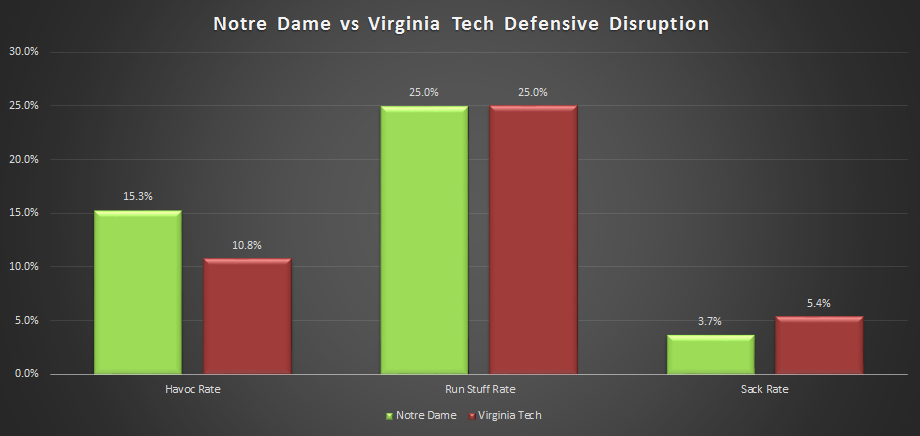
The defense once again played a nice bend but don’t break, a mode which they’ve toggled between when not on the “total QB annihilation” setting. Justin Fuente is a strong offensive mind, and effectively targeting the weak points of the Irish defense early, challenging ND linebackers to defend backs in the pass game and effectively utilizing play action. The run defense was a little less stout than we’ve come to expect, but still stuffed a quarter of VT runs for no gain or less.
Finishing Drives, Field Position, & Turnovers
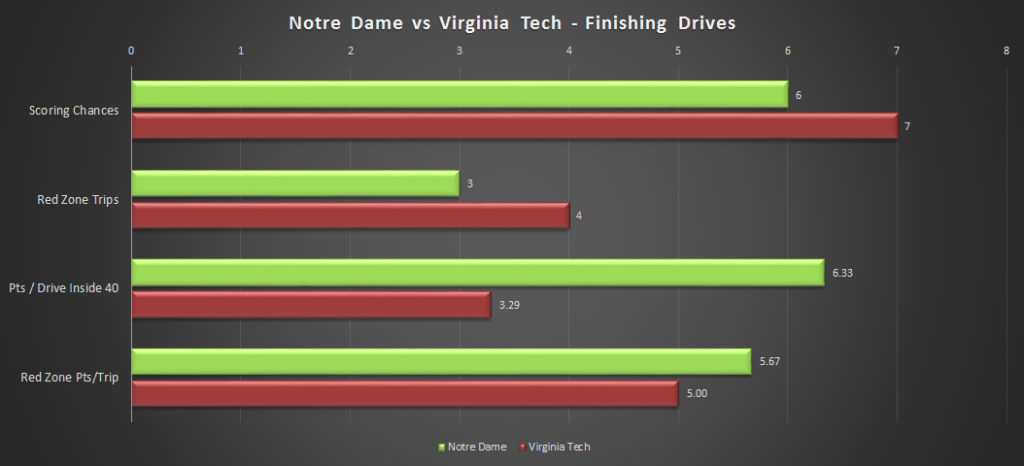
Essential to the win was strong work by both the offense and defense in scoring opportunities. Between holding the Hokies to field goal attempts in key situations (including a 1st and goal from the ND 1) and converting five of six scoring opportunities into touchdowns, the Irish ensured that their explosiveness edge wasn’t wasted. Halfway through the regular season the Notre Dame defense checks in at #8 nationally in allowing just 3.33 points per opponent trip inside the 40.
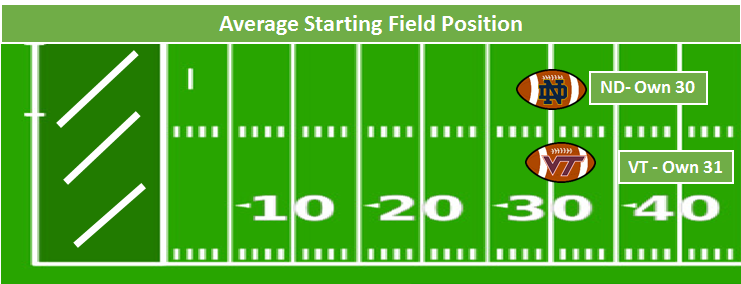
Notre Dame managed to salvage a draw in average starting field position, but was beat up in that area until late in the game, when the VT onside kick and Julian Love pick evened things out. The Hokies continued to allow absolutely nothing in the return game, as they had for most of the season. It was a shakier day for the ND punt team between the botched snap / aborted Newsome punt and a 20-yard return allowed on one where the senior captain out-kicked his coverage a bit. Props to Jonathan Doerer and the kickoff team for much improved execution with the whole “kick it high (in bounds) and pretty deep then tackle” thing.
After winning the turnover battle 2-1, Notre Dame’s +5 margin sits as a top-15 mark nationally. It hasn’t been fluky either – the “expected” turnover margin for the Irish (based on fumble recoveries being 50/50 over the long haul, and a baseline ratio of pass breakups to interceptions) is +5.4, 6th in FBS.
Much of this credit goes to the defense, but the offense also continues to largely make good decisions and execute well. The interception was the only Ian Book pass a Hokie defender got their hands on – zero other pass deflections in the game for a defense that would like to be disruptive. Notre Dame has also fumbled just four times in six games, tied for 10th nationally, with just one of those recovered by an opponent (the Michael Young fumble at Wake).

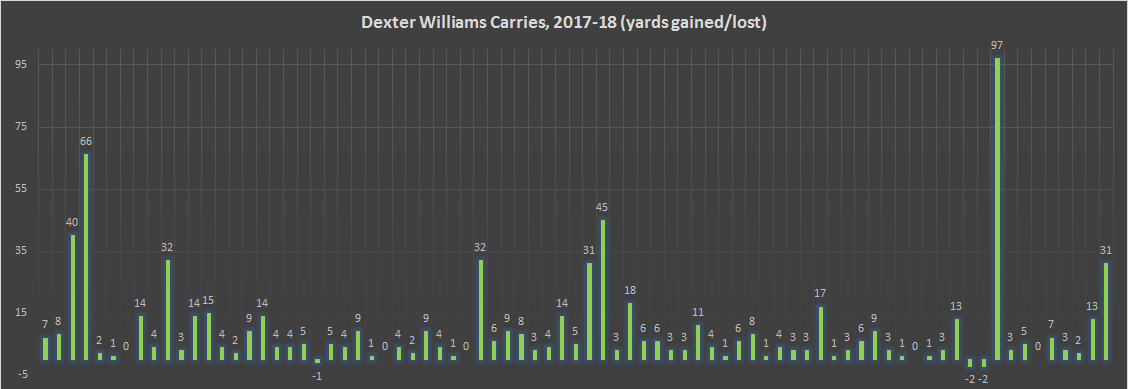



Great write up, Michael.
I’ve rewatched the game a couple of times and that second quarter play calling makes me crazy. Book was near perfect on short/intermediate passes, in a good way, and near perfect on the deep balls, in a very bad way. He wasn’t just off in his accuracy deep, he was way off. I thought Long pushed the deep ball to hard for awhile. Then, when he returned to what’s been working under Book, good things started happening again—a few errant passes, but mostly very accurate, and pretty deadly on third down.
Guess I’m the average ND fan, very happy thus far but not convinced the other shoe won’t drop at some point. This team does have much more balance than I’ve seen for us in a long time, with real playmakers on both sides of the ball, so I’m cautiously optimistic.
Now for Pitt. Just do it.
We wouldn’t be ND fans if we weren’t worried about something, and the two to watch against Pitt (and really, the rest of the way) are the deep passes on offense and how the defense defends offenses attacking LBs and the nickel.
I worry a bit less about the deep throws – the offense has been really effective the last few games without completing many. The glass half full side of it is that 1) the decisions were mostly good by Book, with just one of those into double coverage, and 2) arm strength wasn’t the issue, they were all overthrows. Hopefully Book can work on that touch but he has been so exceptional in the short-intermediate range that it hasn’t made a difference yet.
It will be interesting to me to see how much they continue to challenge defenses deep moving forward – immediately after the game this was BK: “”We said just listen, stop going outside of what you can do, we were trying to do too many things, and I think we got back to doing what we are good at”
Agreed on Book, and I actually liked the 2nd quarter play calls. The defense was challenging us to go over the top by stacking the box, and we had at least 3 or 4 plays with wide open receivers 30+ yards downfield. When it became clear that Book just didn’t quite have the deep ball, the staff did a great job of adjusting at halftime. They tried to beat VT with scheme first, and when the execution was lacking, they said fine we’ll just outmuscle you.
Defenses are going to continue to push defenders up toward the line of scrimmage until Book proves he can beat them deep in 1-on-1 situations. I think he can, but only time will tell. But at some point this season, we won’t just be able to outmuscle an opponent (see Georgia and Miami in 2017), so Book will need to hit on a few. That’s why I think the staff handled the play calling correctly in this one.
Good thoughts MikeyB. I like the analysis. And how can you not throw it downfield when your receivers are that wide open? Who knew Book had the arm of Brandon Wimbush on roids? And why not push the envelope on offense, especially against an overmatched foe. If nothing else it opens up the box and the underneath routes. And now we know that Book is flawless inside of 30 yards and has the arm strength for the deeper balls, he just needs to complete them. Good to put that on film for our later opponents.
I liked seeing the deep balls but, I too, was surprised that Book just couldnt hit ANY of them. I dont know if he was just too excited or what, but yeah everything was 5-10 yards too deep. If he can get that part of his game worked out, omigod.
Per BK he was throwing everything too flat – line-driving it instead of putting some air under it. I kind of wonder if he’s had much practice time with downfield throws. That might sound dumb, I know, but maybe in the offseason and early in-season the focus was on getting him ready as the two-minute guy and they mostly had him do West Coast type stuff.
Even if they didn’t, I think this was the first game where he really had guys running free downfield, so maybe it’s just that it was new in live action. One thing to maybe mitigate excitement here somewhat is that VT’s secondary is really bad; I don’t know that opportunities like he had against them will come as frequently against the rest of the schedule. But yeah, if he figures out how to drop the deep ball in the bucket, look out man.
Agreed. Jamie over on ISD pointed out that teams can only reliably take away one zone from Book. Wake tried to allow him the short zone and bet he couldn’t dink and dunk them to death, and he carved them apart on short throws. Stanford saw that and tried to come up and prevent the short stuff, and he carved them apart on intermediate throws. Virginia Tech also tried to prevent the short stuff, and they did early in a sense because he couldn’t make them pay deep. So we just shifted back to the intermediate zone and, you guessed it, he carved them apart.
The deep throws are a mild concern, but if you’re super-efficient – which he appears to be – there’s no defense around that can reliably shut down two of the three passing zones. Nobody is going to be able to blanket the short and intermediate zones *AND* prevent Book from scrambling for 6-10 yards a pop. It’s just way too much real estate to cover.
Note that I literally mean shut down – of course there are a handful of defenses with exceptional athletes that can make life difficult in multiple zones, like Michigan, Alabama, Clemson, etc. The big question will be if Book can maintain that efficiency against a more athletic, experienced, well-coached defense, which we might not see until the postseason.
FSU has a ton of athletes on defense. I’m really excited to see our offense in that one. I don’t think we’ll be able to simply maul them; it will require a solid scheme to put up a ton of points. If we get into a rut, I don’t think we’ll be able to just shove it down their throat or lob it up to Boykin. I’m not too worried about FSU, but I do think they’ll be a good challenge. A well rounded attack will be able to put up plenty of points, so I’m very interested to see how we look that night.
Their defense is decent; their biggest problem is that their offense screws them repeatedly. Florida State is tied for the third-most punts nationally with 42, and also tied for the third most turnovers with 14. That means they have, on average, 9.3 possessions per game that end in a punt or turnover.
Notre Dame has 26 punts and 6 turnovers, for an average of 5.3 per game. Those four possessions per game are a humongous difference.
Good lord that is gross.
Shouldn’t you like play calls that result in guys 15 yards past every defender? It doesn’t seem like bad play calling to dial up the wide open deep TD play 3 times, even if your QB missed badly on the first two.
FYI the first table in the article under “Basics” is from ND vs. Stanford.
fixed, thanks!
Always love these write-ups! Had a thought that would add even more to the advanced statiness. Now that we’re half way through the season it might be interesting (where relevant) to include opponent’s season averages in each stat category (whether in the charts, in the analysis, or both).
Hmmm like the idea. The tough part is that (as of now) Connelly’s advanced stat profiles don’t include much of these #s. For example, he’s moved from raw success rates now to marginal success rates now, kind of comparing success rate to expected success rates based on down/distance. They might come back at some point when he publishes more detailed offensive and defensive ranks halfway through the season, but those marginal efficiency/explosiveness #’s are outside my capabilities to calculate.
But definitely something for other measures – YPP, havoc, field position – I can think about.
Only mildly stats related comment, but thought it was worth sharing somewhere: This ND team has the fewest number of blue chip recruits on the roster since… [drumroll] …2012.
Is blue chip just 5 stars, or 4 & 5 stars?
Not positive, but I think the “blue chip” distinction is usually more like top 150 or top 200 – the #40 overall player and the #300 overall player are both four stars, and those are obviously pretty different talent levels.
The 2013 recruiting class that signed right after the failed title game was phenomenal, which bumped up the talent level in the program for a while. We signed 13 top 200 players, 12 of whom made it to campus (Eddie YouKnowWho being the lone exception). Those 12 were #2 Jaylon, #29 Redfield, #45 Bryant, #97 Bivin, #106 Folston, #111 Rochell, #115 Elmer, #152 Montelus, #154 Luke, #162 Zaire, #172 McGlinchey, and #193 McGovern.
Not everyone worked out, obviously, but those guys were around for a few years and drove up the blue-chip ratio on the roster. I think the staff has done a really good job of evaluating guys in the last few classes to land guys like Love, Tranquill, MTA, Claypool, etc., and we’re starting to see the dividends now.
I’m pretty sure the blue chip ratio is just 4 star, at least for the calculations Connelly does. And the difference in ratio between Bama/tOSU and us is enough to explain the differing performance, you don’t really need to dig into top 100/200.
Yes, those guys get more top 100 players, but they also get more low 4 stars Recruiting 4 star vs top 100 is like efficiency vs explosiveness. The latter generally being a result of being good at the former. Very few 5 stars go to teams that otherwise recruit few 4 stars. It’s all correlated.
By my count, if I remember correctly, at least half of the 12 were busts, or played but seriously underperformed
4 and 5 star as I was meaning it.
Just 5 star would be *ELITE*
For reference, the number of 4 and 5 stars on the team by year:
2018- 44
2017- 47
2016- 53
2015- 54
2014- 46
2013- 42*
2012- 35
*Just realized at 3 in the morning I wasn’t looking at the numbers right and this is the fewest since 2013.
I wonder what 15/16 would have been like without VanGorder.
One thing I was upset with in this game was the lack of Jerry Tillery. Where was that guy practically all game? We need him to be a force and you see why. When he’s not making plays or disrupting the middle of the field, teams like VT move the ball on us pretty well. Hope to see him go back into monster mode the second half of the year.
VT did some different things to try to neutralize him. They threw a bunch of screens and I think he saw more double teams than usual; I’m not sure on this, but I would bet that was especially true after Okwara was tossed. As a 3-tech doubling him means you’re putting a TE or a RB on the DE on that side, which was probably less concerning against Ogundeji and Ademilola than it would’ve been against Okwara.
He also slipped a few times when he was rushing, not sure if there was a surface or shoe issue or what but that obviously didn’t help. He was great against the run, though, and he was chasing some of those screens down too. And he did have a couple of pressures – I remember one PBU downfield that happened because he came straight up the gut and had a hand in Willis’s face.
Yeah, I know he made plays and he did make a difference on the D. I just really like to see the monster side of him. Where he’s getting 2-3 sacks, 2-3 TFL, that kind of thing. Just playing his role as a NT is “meh”
I thought the exact same thing in real time. And he still ended up with 5 tackles, which is pretty good. It’s a weird feeling to just expect an ND d-lineman to have a huge game every week. Haven’t felt that way in a long time.
He chased down at least one screen pass and was in on, or at least near, some tackles on the sidelines. I’d actually rather see that from him once in a while. When you are used to dominating, it’s easy to just do that, but nice to see him put in big effort on plays that he wouldn’t be expected to be a part of.
One item to note on JT is that he’s moved from lining up as the traditional nose tackle last year, zero or one “tech” as the kids are calling it — that is lining up over the center or an A gap, to more of a strong side defensive tackle, a two or three tech — lining up over the guard or B gap. This is great for him because it lets him stunt more and is likely the position that NFL teams would be looking at him for.